
The 1820s was a decade of the Gregorian calendar that began on January 1, 1820, and ended on December 31, 1829.

The Greek War of Independence, also known as the Greek Revolution or the Greek Revolution of 1821, was a successful war of independence by Greek revolutionaries against the Ottoman Empire between 1821 and 1829. In 1826, the Greeks were assisted by the British Empire, Kingdom of France, and the Russian Empire, while the Ottomans were aided by their North African vassals, particularly the eyalet of Egypt. The war led to the formation of modern Greece, which would be expanded to its modern size in later years. The revolution is celebrated by Greeks around the world as independence day on 25 March every year.

The national flag of Greece, popularly referred to as the "turquoise and white one" or the "azure and white", is officially recognised by Greece as one of its national symbols and has 5 equal horizontal stripes of blue alternating with white. There is a blue canton in the upper hoist-side corner bearing a white cross; the cross symbolises Eastern Orthodox Christianity. The blazon of the flag is Azure, four bars Argent; on a canton of the field a Greek cross throughout of the second. The official flag ratio is 2:3. The shade of blue used in the flag has varied throughout its history, from light blue to dark blue, the latter being increasingly used since the late 1960s. It was officially adopted by the First National Assembly at Epidaurus on 13 January 1822.

Elis or Ilia is a historic region in the western part of the Peloponnese peninsula of Greece. It is administered as a regional unit of the modern region of Western Greece. Its capital is Pyrgos. Until 2011 it was Elis Prefecture, covering the same territory.
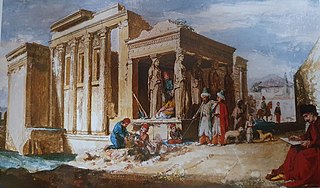
The majority of the territory of present-day Greece was at some point incorporated within the Ottoman Empire. The period of Ottoman rule in Greece, lasting from the mid-15th century to the successful Greek War of Independence that broke out in 1821 and the First Hellenic Republic was proclaimed in 1822, is known in Greek as Tourkokratia. Some regions, however, like the Ionian islands and various temporary Venetian possessions of the Stato da Mar were not incorporated in the Ottoman Empire. The Mani Peninsula in Peloponnese was not fully integrated into the Ottoman Empire, but was under Ottoman suzerainty.

Eleftheria i thanatos is the motto of Greece. It originated in the Greek songs of resistance that were powerful motivating factors for independence. It was adopted in 1814 by the Filiki Eteria, a secret organization formed specifically for the overthrow of Ottoman rule.
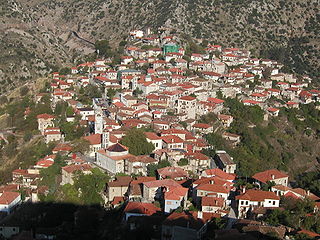
Dimitsana is a mountain village and a former municipality in Arcadia, Peloponnese, Greece. Since the 2011 local government reform it is part of the municipality Gortynia, of which it is the seat and a municipal unit. The municipal unit has an area of 110.759 km2. Dimitsana is built on the ruins of the ancient town Teuthis. The population of the village is 342, while it was 611 in 2001. It has been registered as a traditional settlement.

Grigorios Dimitrios Dikaios-Flessas, popularly known as Papaflessas was a Greek priest and government official who became one of the most influential figures during the Greek War of Independence. The prefix papa- (παπα-) in the name Papaflessas indicates his status as a cleric since the word means 'priest' in Greek. He was appointed Archimandrite in 1819. He served as Minister of Internal Affairs and Chief of Police in the government of Alexander Mavrokordatos. Papaflessas was killed during the Battle of Maniaki on May 20, 1825, fighting against the forces of Ibrahim Pasha at Maniaki, Messinia.

Kalavryta is a town and a municipality in the mountainous east-central part of the regional unit of Achaea, Greece. The town is located on the right bank of the river Vouraikos, 24 kilometres south of Aigio, 40 km southeast of Patras and 62 km northwest of Tripoli. Notable mountains in the municipality are Mount Erymanthos in the west and Aroania or Chelmos in the southeast. Kalavryta is the southern terminus of the Diakopto-Kalavryta rack railway, built by Italian engineers between 1885 and 1895.
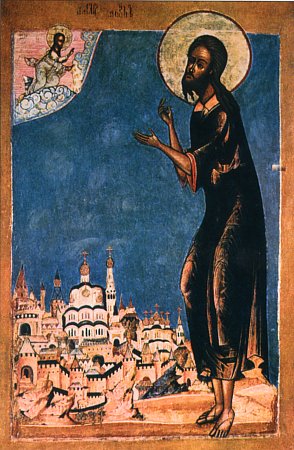
Saint Alexiusof Rome or Alexius of Edessa, also Alexis, was a fourth-century Greek monk who lived in anonymity and is known for his dedication to Christ. Two versions of his life exist, one in Syriac and the other in Greek.

March 24 - Eastern Orthodox liturgical calendar - March 26

Petros Mavromichalis, also known as Petrobey, was a Greek general, politician and the leader of the Maniot people during the first half of the 19th century. His family had a long history of revolts against the Ottoman Empire, which ruled most of what is now Greece. His grandfather Georgios and his father Pierros were among the leaders of the Orlov Revolt.
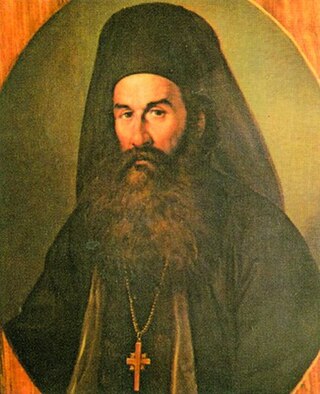
Germanos III of Old Patras, born Georgios Kontzias, was an Orthodox Metropolitan of Patras. He played an important role in the Greek Revolution of 1821, having diplomatic and political activity.
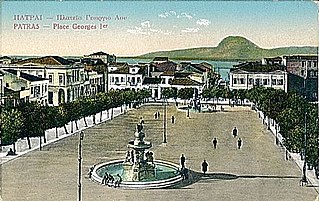
The city of Patras has an important history of four thousand years. Patras has been inhabited since the prehistoric age and constituted an important centre of the Mycenean era. In antiquity it was a leading member of the Achaean League. Patras reached the peak of its power in the Roman era, when an imperial colony was founded there by Augustus. In the Byzantine period it remained a commercial city. The town experienced repeated conquests from Franks, Venice, Byzantines and finally the Ottomans. Later on, it played a leading part in the Greek revolution of 1821, the first revolt of which in Greece, broke out in Patras. In 19th century Greece, it was the indisputable centre of the Peloponnese, an important export harbour, and a cradle of the emerging Greek middle class. In the 20th century the city developed as a commercial and industrial hub and in spite of its overshadowing by Athens, it is now the third city of Greece and the most significant economic pole of Peloponnese and West Greece.
This is a timeline of modern Greek history.

There were numerous massacres during the Greek War of Independence (1821-1829) perpetrated by both the Ottoman forces and the Greek revolutionaries. The war was characterized by a lack of respect for civilian life, and prisoners of war on both sides of the conflict. Massacres of Greeks took place especially in Ionia, Crete, Constantinople, Macedonia and the Aegean islands. Turkish, Albanian, Greeks, and Jewish populations, who were identified with the Ottomans inhabiting the Peloponnese, suffered massacres, particularly where Greek forces were dominant. Settled Greek communities in the Aegean Sea, Crete, Central and Southern Greece were wiped out, and settled Turkish, Albanian, Greeks, and smaller Jewish communities in the Peloponnese were destroyed.

Andreas S. Londos was a Greek military leader and politician.
The Senate of the entire People of the Peloponnese provinces, commonly known as the Peloponnesian Senate, was a provisional regime that existed in the Peloponnese during the early stages of the Greek War of Independence.
The Metropolis of Elis and Olena is a Greek Orthodox episcopal see of the Church of Greece. During the period of Frankish rule it was a Roman Catholic see, and continues to the present day as a titular see in the Roman Catholic Church.

The celebration of the Greek Revolution of 1821, less commonly known as Independence Day, takes place in Greece, Cyprus and Greek diaspora centers on 25 March every year, coinciding with the Feast of the Annunciation.






















